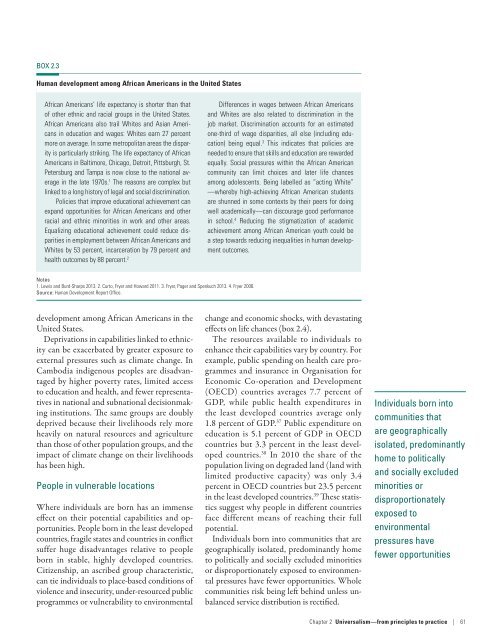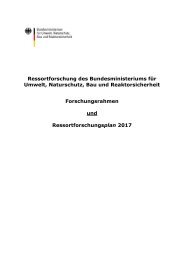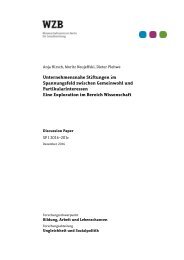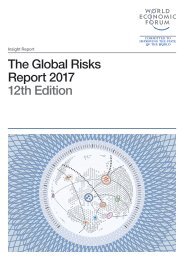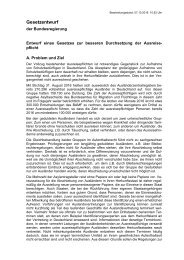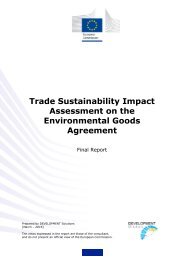Human Development Report 2016
6Tyccfrzw
6Tyccfrzw
Create successful ePaper yourself
Turn your PDF publications into a flip-book with our unique Google optimized e-Paper software.
BOX 2.3<br />
<strong>Human</strong> development among African Americans in the United States<br />
African Americans’ life expectancy is shorter than that<br />
of other ethnic and racial groups in the United States.<br />
African Americans also trail Whites and Asian Americans<br />
in education and wages: Whites earn 27 percent<br />
more on average. In some metropolitan areas the disparity<br />
is particularly striking. The life expectancy of African<br />
Americans in Baltimore, Chicago, Detroit, Pittsburgh, St.<br />
Petersburg and Tampa is now close to the national average<br />
in the late 1970s. 1 The reasons are complex but<br />
linked to a long history of legal and social discrimination.<br />
Policies that improve educational achievement can<br />
expand opportunities for African Americans and other<br />
racial and ethnic minorities in work and other areas.<br />
Equalizing educational achievement could reduce disparities<br />
in employment between African Americans and<br />
Whites by 53 percent, incarceration by 79 percent and<br />
health outcomes by 88 percent. 2<br />
Differences in wages between African Americans<br />
and Whites are also related to discrimination in the<br />
job market. Discrimination accounts for an estimated<br />
one-third of wage disparities, all else (including education)<br />
being equal. 3 This indicates that policies are<br />
needed to ensure that skills and education are rewarded<br />
equally. Social pressures within the African American<br />
community can limit choices and later life chances<br />
among adolescents. Being labelled as “acting White”<br />
— whereby high-achieving African American students<br />
are shunned in some contexts by their peers for doing<br />
well academically — can discourage good performance<br />
in school. 4 Reducing the stigmatization of academic<br />
achievement among African American youth could be<br />
a step towards reducing inequalities in human development<br />
outcomes.<br />
Notes<br />
1. Lewis and Burd-Sharps 2013. 2. Curto, Fryer and Howard 2011. 3. Fryer, Pager and Spenkuch 2013. 4. Fryer 2006.<br />
Source: <strong>Human</strong> <strong>Development</strong> <strong>Report</strong> Office.<br />
development among African Americans in the<br />
United States.<br />
Deprivations in capabilities linked to ethnicity<br />
can be exacerbated by greater exposure to<br />
external pressures such as climate change. In<br />
Cambodia indigenous peoples are disadvantaged<br />
by higher poverty rates, limited access<br />
to education and health, and fewer representatives<br />
in national and subnational decisionmaking<br />
institutions. The same groups are doubly<br />
deprived because their livelihoods rely more<br />
heavily on natural resources and agriculture<br />
than those of other population groups, and the<br />
impact of climate change on their livelihoods<br />
has been high.<br />
People in vulnerable locations<br />
Where individuals are born has an immense<br />
effect on their potential capabilities and opportunities.<br />
People born in the least developed<br />
countries, fragile states and countries in conflict<br />
suffer huge disadvantages relative to people<br />
born in stable, highly developed countries.<br />
Citizenship, an ascribed group characteristic,<br />
can tie individuals to place-based conditions of<br />
violence and insecurity, under-resourced public<br />
programmes or vulnerability to environmental<br />
change and economic shocks, with devastating<br />
effects on life chances (box 2.4).<br />
The resources available to individuals to<br />
enhance their capabilities vary by country. For<br />
example, public spending on health care programmes<br />
and insurance in Organisation for<br />
Economic Co-operation and <strong>Development</strong><br />
(OECD) countries averages 7.7 percent of<br />
GDP, while public health expenditures in<br />
the least developed countries average only<br />
1.8 percent of GDP. 37 Public expenditure on<br />
education is 5.1 percent of GDP in OECD<br />
countries but 3.3 percent in the least developed<br />
countries. 38 In 2010 the share of the<br />
population living on degraded land (land with<br />
limited productive capacity) was only 3.4<br />
percent in OECD countries but 23.5 percent<br />
in the least developed countries. 39 These statistics<br />
suggest why people in different countries<br />
face different means of reaching their full<br />
potential.<br />
Individuals born into communities that are<br />
geographically isolated, predominantly home<br />
to politically and socially excluded minorities<br />
or disproportionately exposed to environmental<br />
pressures have fewer opportunities. Whole<br />
communities risk being left behind unless unbalanced<br />
service distribution is rectified.<br />
Individuals born into<br />
communities that<br />
are geographically<br />
isolated, predominantly<br />
home to politically<br />
and socially excluded<br />
minorities or<br />
disproportionately<br />
exposed to<br />
environmental<br />
pressures have<br />
fewer opportunities<br />
Chapter 2 Universalism—from principlesto practice | 61


